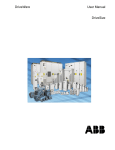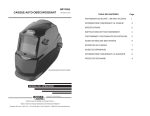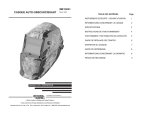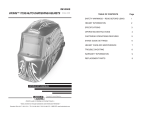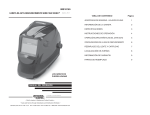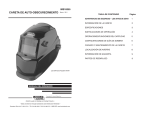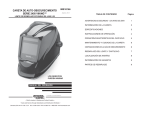Download Lincoln Electric IM10001 User's Manual
Transcript
RETURN TO MAIN MENU IM10001 AUTO-DARKENING HELMET February, 2009 OPERATOR’S MANUAL Copyright © Lincoln Global Inc. • World's Leader in Welding and Cutting Products • • Sales and Service through Subsidiaries and Distributors Worldwide • Cleveland, Ohio 44117-1199 U.S.A. TEL: 216.481.8100 FAX: 216.486.1751 WEB SITE: www.lincolnelectric.com TABLE OF CONTENTS Page SAFETY WARNINGS – READ BEFORE USING 1 HELMET INFORMATION 2 SPECIFICATIONS 3 OPERATING INSTRUCTIONS 4 CARTRIDGE OPERATIONS/FEATURES 5 SHADE GUIDE SETTINGS 6 HELMET CARE AND MAINTENANCE 7 TROUBLE SHOOTING 8 WARRANTY INFORMATION 9 REPLACEMENT PARTS 9 IM10001 AUTO-DARKENING HELMET February, 2009 OPERATOR’S MANUAL Copyright © Lincoln Global Inc. • World's Leader in Welding and Cutting Products • • Sales and Service through Subsidiaries and Distributors Worldwide • Cleveland, Ohio 44117-1199 U.S.A. TEL: 216.481.8100 FAX: 216.486.1751 WEB SITE: www.lincolnelectric.com TABLE OF CONTENTS Page SAFETY WARNINGS – READ BEFORE USING 1 HELMET INFORMATION 2 SPECIFICATIONS 3 OPERATING INSTRUCTIONS 4 CARTRIDGE OPERATIONS/FEATURES 5 SHADE GUIDE SETTINGS 6 HELMET CARE AND MAINTENANCE 7 TROUBLE SHOOTING 8 WARRANTY INFORMATION 9 REPLACEMENT PARTS 9 SAFETY WARNINGS – READ BEFORE USING WARNING HELMET INFORMATION This Auto-Darkening Welding Helmet will automatically change from a light state (shade 3.5) to a dark state (Shade 9-13) when arc welding starts. The filter automatically returns to a light state when the arc stops. Shade control adjustments can be made while welding. ARC Rays can injure eyes and burn skin • Before welding, always inspect helmet and filter lens to be sure they are fitted properly, in good condition and not damaged. • Check to see that the clear lens is clean and securely attached to the helmet. • Always wear safety glasses or goggles under the welding helmet and protective clothing to protect your skin from radiation, burns and spatter. • Ensure that optical radiation from other welder’s arcs in the immediate area does not enter in from behind the helmet and auto-darkening filter. Note: Auto-darkening filters in Lincoln helmets are designed to protect the user against harmful ultra-violet and infrared rays both in the dark and light states. No matter what shade the filter is set to, the UV/IR protection is always present. FUMES AND GASES can be dangerous to your health. • Keep your head out of fumes. • Use enough ventilation or exhaust at the arc or both to keep fumes and gases from your breathing zone and general area. • When welding with electrodes which require special ventilation such as stainless or hard facing (see instructions on container or MSDS) or on lead or cadmium plated steel and other metals or coatings which produce highly toxic fumes, keep exposure as low as possible and within applicable OSHA PEL and ACGIH TLV limits using local exhaust or mechanical ventilation. In confined spaces or in some circumstances, outdoors, a respirator may be required. Additional precautions are also required when welding on galvanized steel. Match your welding application to the shade indicated on the shade chart. (See Page 6) • Operating temperature: 14°F ~ 131°F (-10°C ~ 55°C). • Do not use or open the auto-darkening filter if damaged by shock, vibration or pressure. • Keep the sensors and solar cell clean. Clean the filter cartridge using a soapy water solution and soft cloth which should be damp but not saturated. This Auto-Darkening Welding Helmet is designed for use with GMAW, GTAW, MMAW welding, or Plasma Arc and air carbon arc cutting. The cartridge provides protection from harmful UV and IR radiation, in both dark and light states. The cartridge contains two sensors to detect the light from the welding arc, resulting in the lens darkening to a selected welding shade. • Do not use solvents or abrasive cleaning detergent. • If cover lens is spattered or covered with dirt, it should be replaced immediately. • Use only replacement parts specified in this manual. • Do not use the helmet without inside and outside cover lenses properly installed. Refer to http://www.lincolnelectric.com/safety for additional safety information. 2 1 SAFETY WARNINGS – READ BEFORE USING WARNING HELMET INFORMATION This Auto-Darkening Welding Helmet will automatically change from a light state (shade 3.5) to a dark state (Shade 9-13) when arc welding starts. The filter automatically returns to a light state when the arc stops. Shade control adjustments can be made while welding. ARC Rays can injure eyes and burn skin • Before welding, always inspect helmet and filter lens to be sure they are fitted properly, in good condition and not damaged. • Check to see that the clear lens is clean and securely attached to the helmet. • Always wear safety glasses or goggles under the welding helmet and protective clothing to protect your skin from radiation, burns and spatter. • Ensure that optical radiation from other welder’s arcs in the immediate area does not enter in from behind the helmet and auto-darkening filter. Note: Auto-darkening filters in Lincoln helmets are designed to protect the user against harmful ultra-violet and infrared rays both in the dark and light states. No matter what shade the filter is set to, the UV/IR protection is always present. FUMES AND GASES can be dangerous to your health. • Keep your head out of fumes. • Use enough ventilation or exhaust at the arc or both to keep fumes and gases from your breathing zone and general area. • When welding with electrodes which require special ventilation such as stainless or hard facing (see instructions on container or MSDS) or on lead or cadmium plated steel and other metals or coatings which produce highly toxic fumes, keep exposure as low as possible and within applicable OSHA PEL and ACGIH TLV limits using local exhaust or mechanical ventilation. In confined spaces or in some circumstances, outdoors, a respirator may be required. Additional precautions are also required when welding on galvanized steel. Match your welding application to the shade indicated on the shade chart. (See Page 6) • Operating temperature: 14°F ~ 131°F (-10°C ~ 55°C). • Do not use or open the auto-darkening filter if damaged by shock, vibration or pressure. • Keep the sensors and solar cell clean. Clean the filter cartridge using a soapy water solution and soft cloth which should be damp but not saturated. This Auto-Darkening Welding Helmet is designed for use with GMAW, GTAW, MMAW welding, or Plasma Arc and air carbon arc cutting. The cartridge provides protection from harmful UV and IR radiation, in both dark and light states. The cartridge contains two sensors to detect the light from the welding arc, resulting in the lens darkening to a selected welding shade. • Do not use solvents or abrasive cleaning detergent. • If cover lens is spattered or covered with dirt, it should be replaced immediately. • Use only replacement parts specified in this manual. • Do not use the helmet without inside and outside cover lenses properly installed. Refer to http://www.lincolnelectric.com/safety for additional safety information. 2 1 SPECIFICATIONS OPERATING INSTRUCTIONS Headgear Adjustment LCD Viewing Area 97 x 44mm (3.82 x 1.73in) Cartridge size 110 x 90mm (4.33 x 3.54in) UV/IR Protection Up to Shade DIN 16 at all times Arc Sensors 2 Light State Shade DIN 4 Variable Welding Shades DIN 9 to 13 Shade Control External knob - full adjustment Power Supply Solar cells - no battery required Power On/Off Fully automatic Light to Dark Switching Time 0.00004 sec (1/25,000 sec) Sensitivity Control High (normal) and Low (extreme ambient light) HEAD GEAR FORE / AFT ADJUSTMENT TILT ADJUSTMENT CROWN ADJUSTMENT PIN HOLES FOR ADJUSTMENT RATCHET KNOB Delay Control (Dark to Light) (0.25~0.35s <fast>) (1) (0.60~0.80s<slow>) TIG Rating 10 amps Operating Temperature 14°F ~ 131°F (-10°C ~ 55°C) Storage Temperature -4° ~ 158°F (-20°C ~ 70°C) Total Weight 440g (15.5 Oz.) Compliance(1) ANSI Z87.1-2003/CSA Z94.3 Headgear compliance with ANSI Z87.1 is without sweatband installed. 3 Head Size Adjustment: Headband tightness is adjusted by pushing in the ratchet knob and turning to adjust to desired comfort level. This knob is located at the back of the helmet. HEAD GEAR CROWN ADJUSTMENT is made by adjusting crown strap for vertical placement on the head and snapping the pin into the hole to lock securely in place. Tilt: Tilt adjustment is adjusted on both the left and right sides of helmet. TILT is adjusted by loosening outside tension knobs and releasing the adjustment lever from its current location and moving it to another location (one side at a time is recommended). Retighten the outside tension knobs when finished. NOTE: This adjustment location needs to be the same for the right and left side levers. Fore / Aft Adjustment: Fore/Aft adjustment is the distance between the user’s face and lens. To adjust, loosen the outside tension knobs to allow the bolts to be repositioned in a different location (one side at a time is recommended). NOTE: Make sure both sides are located the same for proper operation. 4 SPECIFICATIONS OPERATING INSTRUCTIONS Headgear Adjustment LCD Viewing Area 97 x 44mm (3.82 x 1.73in) Cartridge size 110 x 90mm (4.33 x 3.54in) UV/IR Protection Up to Shade DIN 16 at all times Arc Sensors 2 Light State Shade DIN 4 Variable Welding Shades DIN 9 to 13 Shade Control External knob - full adjustment Power Supply Solar cells - no battery required Power On/Off Fully automatic Light to Dark Switching Time 0.00004 sec (1/25,000 sec) Sensitivity Control High (normal) and Low (extreme ambient light) HEAD GEAR FORE / AFT ADJUSTMENT TILT ADJUSTMENT CROWN ADJUSTMENT PIN HOLES FOR ADJUSTMENT RATCHET KNOB Delay Control (Dark to Light) (0.25~0.35s <fast>) (1) (0.60~0.80s<slow>) TIG Rating 10 amps Operating Temperature 14°F ~ 131°F (-10°C ~ 55°C) Storage Temperature -4° ~ 158°F (-20°C ~ 70°C) Total Weight 440g (15.5 Oz.) Compliance(1) ANSI Z87.1-2003/CSA Z94.3 Headgear compliance with ANSI Z87.1 is without sweatband installed. 3 Head Size Adjustment: Headband tightness is adjusted by pushing in the ratchet knob and turning to adjust to desired comfort level. This knob is located at the back of the helmet. HEAD GEAR CROWN ADJUSTMENT is made by adjusting crown strap for vertical placement on the head and snapping the pin into the hole to lock securely in place. Tilt: Tilt adjustment is adjusted on both the left and right sides of helmet. TILT is adjusted by loosening outside tension knobs and releasing the adjustment lever from its current location and moving it to another location (one side at a time is recommended). Retighten the outside tension knobs when finished. NOTE: This adjustment location needs to be the same for the right and left side levers. Fore / Aft Adjustment: Fore/Aft adjustment is the distance between the user’s face and lens. To adjust, loosen the outside tension knobs to allow the bolts to be repositioned in a different location (one side at a time is recommended). NOTE: Make sure both sides are located the same for proper operation. 4 CARTRIDGE OPERATION/FEATURES Variable Shade Control The shade can be adjusted from shade 9 to 13 based upon welding process or application (refer to Shade selection chart on page 6). The variable shade control knob is mounted to shell for external adjustment. ALWAYS TEST TO BE SURE THE ADF CARTRIDGE IS CHARGED BEFORE WELDING. The helmet can be placed in sunlight to charge. Do not store the helmet in a dark cabinet or other storage area for long periods. While welding, the arc also charges the ADF cartridge. SHADE GUIDE SETTINGS GUIDE FOR SHADE NUMBERS Sensitivity Control You can adjust the light sensor by selecting the HIGH or LOW position of the sensitivity switch as shown in figure below. Generally, the HIGH setting is selected for normal use. Where the helmet is used in the presence of excess ambient light or with another welding machine close by, the LOW setting may be selected for better performance. Delay Time Control This control is designed to protect the welder’s eyes from the strong residual rays after welding. You can delay the time of change to light state from the darkened state with setting delay control switch on FAST or SLOW. The SLOW setting is recommended for high amperage applications where the weld puddle is still very bright after the welding arc has ceased and for situations where the filter may be temporarily blocked from seeing the welding arc. Solar Power This helmet is powered by solar energy. As such, there is no battery that requires replacement. OPERATION ELECTRODE SIZE 1/32 in. (mm) ARC CURRENT (A) MINIMUM PROTECTIVE SHADE SUGGESTED(1) SHADE NO. (COMFORT) Shielded metal arc welding Less than 3 (2.5) 3-5 (2.5–4) 5-8 (4–6.4) More than 8 (6.4) Less than 60 60-160 160-250 250-550 7 8 10 11 – 10 12 14 Gas metal arc welding and flux cored arc welding Less than 60 60-160 160-250 250-500 7 10 10 10 – 11 12 14 Gas tungsten arc welding Less than 50 50-150 150-500 8 8 10 10 12 14 Less than 500 500-1000 10 11 12 14 Less than 20 20-100 100-400 400-800 6 8 10 11 6 to 8 10 12 14 Less than 300 300-400 400-800 8 9 10 9 12 14 Torch brazing – – 3 or 4 Torch soldering – – 2 Carbon arc welding – – 14 Air carbon Arc cutting (Light) (Heavy) Plasma arc welding Plasma arc cutting (2) (Light) (2) (Medium) (Heavy)(2) in. SENSITIVITY HIGH LOW PLATE THICKNESS mm Gas welding Light Medium Heavy Under 1/8 1/8 to 1/2 Over 1/2 Under 3.2 3.2 to 12.7 Over 12.7 4 or 5 5 or 6 6 or 8 Oxygen cutting Light Medium Heavy Under 1 1 to 6 Over 6 Under 25 25 to 150 Over 150 3 or 4 4 or 5 5 or 6 DELAY TIME SLOW FAST (1) As a rule of thumb, start with a shade that is too dark, then go to a lighter shade which gives sufficient view of the weld zone without going below the minimum. In oxyfuel gas welding or cutting where the torch produces a high yellow light, it is desirable to use a filter lens that absorbs the yellow or sodium line the visible light of the (spectrum) operation . (2) These values apply where the actual arc is clearly seen. Experience has shown that lighter filters may be used when the arc is hidden by the workpiece. Data from ANSI Z49.1-2005 If your helmet does not include any one of the shades referenced above, it is recommended you use the next darker shade. Variable shade control Knob 5 6 CARTRIDGE OPERATION/FEATURES Variable Shade Control The shade can be adjusted from shade 9 to 13 based upon welding process or application (refer to Shade selection chart on page 6). The variable shade control knob is mounted to shell for external adjustment. ALWAYS TEST TO BE SURE THE ADF CARTRIDGE IS CHARGED BEFORE WELDING. The helmet can be placed in sunlight to charge. Do not store the helmet in a dark cabinet or other storage area for long periods. While welding, the arc also charges the ADF cartridge. SHADE GUIDE SETTINGS GUIDE FOR SHADE NUMBERS Sensitivity Control You can adjust the light sensor by selecting the HIGH or LOW position of the sensitivity switch as shown in figure below. Generally, the HIGH setting is selected for normal use. Where the helmet is used in the presence of excess ambient light or with another welding machine close by, the LOW setting may be selected for better performance. Delay Time Control This control is designed to protect the welder’s eyes from the strong residual rays after welding. You can delay the time of change to light state from the darkened state with setting delay control switch on FAST or SLOW. The SLOW setting is recommended for high amperage applications where the weld puddle is still very bright after the welding arc has ceased and for situations where the filter may be temporarily blocked from seeing the welding arc. Solar Power This helmet is powered by solar energy. As such, there is no battery that requires replacement. OPERATION ELECTRODE SIZE 1/32 in. (mm) ARC CURRENT (A) MINIMUM PROTECTIVE SHADE SUGGESTED(1) SHADE NO. (COMFORT) Shielded metal arc welding Less than 3 (2.5) 3-5 (2.5–4) 5-8 (4–6.4) More than 8 (6.4) Less than 60 60-160 160-250 250-550 7 8 10 11 – 10 12 14 Gas metal arc welding and flux cored arc welding Less than 60 60-160 160-250 250-500 7 10 10 10 – 11 12 14 Gas tungsten arc welding Less than 50 50-150 150-500 8 8 10 10 12 14 Less than 500 500-1000 10 11 12 14 Less than 20 20-100 100-400 400-800 6 8 10 11 6 to 8 10 12 14 Less than 300 300-400 400-800 8 9 10 9 12 14 Torch brazing – – 3 or 4 Torch soldering – – 2 Carbon arc welding – – 14 Air carbon Arc cutting (Light) (Heavy) Plasma arc welding Plasma arc cutting (2) (Light) (2) (Medium) (Heavy)(2) in. SENSITIVITY HIGH LOW PLATE THICKNESS mm Gas welding Light Medium Heavy Under 1/8 1/8 to 1/2 Over 1/2 Under 3.2 3.2 to 12.7 Over 12.7 4 or 5 5 or 6 6 or 8 Oxygen cutting Light Medium Heavy Under 1 1 to 6 Over 6 Under 25 25 to 150 Over 150 3 or 4 4 or 5 5 or 6 DELAY TIME SLOW FAST (1) As a rule of thumb, start with a shade that is too dark, then go to a lighter shade which gives sufficient view of the weld zone without going below the minimum. In oxyfuel gas welding or cutting where the torch produces a high yellow light, it is desirable to use a filter lens that absorbs the yellow or sodium line the visible light of the (spectrum) operation . (2) These values apply where the actual arc is clearly seen. Experience has shown that lighter filters may be used when the arc is hidden by the workpiece. Data from ANSI Z49.1-2005 If your helmet does not include any one of the shades referenced above, it is recommended you use the next darker shade. Variable shade control Knob 5 6 HELMET CARE AND MAINTENANCE TROUBLE SHOOTING GUIDE Replacing Front Cover Lens: Replace the front cover lens if it is damaged – cracked, soiled or pitted. Place your finger or thumb into recess (C) at the bottom edge of the cover lens and flex the lens upwards until it releases from the edges marked A and B. (Refer to figure 1). Use only the replacement front cover lenses specified in this manual. Test your shade cartridge prior to welding by directing the front of the cartridge toward a bright source of light, then using your fingers rapidly cover and uncover the sensors. The cartridge should darken momentarily as the sensor is exposed. A torch striker can also be used. POSSIBLE CAUSE SOLUTION PROBLEM Replace the Inside Cover Lens: if it is damaged (cracked, soiled or pitted). Place your fingernail in recess above cartridge view window and flex lens upwards until it releases from edges of cartridge view window. Difficult to see through Front cover lens dirty. filter. Cartridge dirty. Change the Shade Cartridge (See figure 2) Fitting New Cartridge: Take the new shade cartridge and pass the potentiometer cable under the wire loop before placing the cartridge into its retaining frame inside the helmet. Hinge down the wire loop and ensure the front edge of the loop (D) is properly retained under the retaining lugs (E) as shown in (figure 3). Filter does not darken when arc is struck. Front cover lens is damaged. Sensors are blocked or Solar panel is blocked. Position the shade potentiometer to the inside of the helmet with the shaft protruding through the hole. Secure potentiometer to shell. On the outside of the helmet, push the shade control knob onto the shaft. Cleaning: Clean helmet by wiping with a soft cloth. Clean cartridge surfaces regularly. Do not use strong cleaning solutions. Clean sensors and solar cells with soapy water solution and a clean cloth and wipe dry with a lint-free cloth. Do NOT submerge shade cartridge in water or other solution. Storage: Store in a clean, dry location. Sensitivity is set on LOW. Front cover lens dirty. Filter darkening without arc being struck. Filter remains dark after completing a weld. Sensitivity set to HIGH. Clean or replace front cover lens. Clean the Auto-Darkening cartridge with soapy water solution and soft cloth. Set sensitivity to HIGH Clean or replace front cover lens. Check for cracked or pitted front cover lens and replace as required. Make sure you are not blocking the sensors or solar panels with your arm or other obstacle while welding. Adjust your position so that the sensors can see the weld arc. Set sensitivity to LOW Delay time set to SLOW. Set delay time to FAST. WARNING ADF is cracked. Cease (STOP) using this product if this problem exists. UV/IR protection may be compromised resulting in burns to the eyes and skin. Weld spatter Missing, damaged, is damaging broken, cracked or distorted front cover the filter. lens Figure 1 Figure 2 7 Figure 3 8 Replace front cover lens as needed. HELMET CARE AND MAINTENANCE TROUBLE SHOOTING GUIDE Replacing Front Cover Lens: Replace the front cover lens if it is damaged – cracked, soiled or pitted. Place your finger or thumb into recess (C) at the bottom edge of the cover lens and flex the lens upwards until it releases from the edges marked A and B. (Refer to figure 1). Use only the replacement front cover lenses specified in this manual. Test your shade cartridge prior to welding by directing the front of the cartridge toward a bright source of light, then using your fingers rapidly cover and uncover the sensors. The cartridge should darken momentarily as the sensor is exposed. A torch striker can also be used. POSSIBLE CAUSE SOLUTION PROBLEM Replace the Inside Cover Lens: if it is damaged (cracked, soiled or pitted). Place your fingernail in recess above cartridge view window and flex lens upwards until it releases from edges of cartridge view window. Difficult to see through Front cover lens dirty. filter. Cartridge dirty. Change the Shade Cartridge (See figure 2) Fitting New Cartridge: Take the new shade cartridge and pass the potentiometer cable under the wire loop before placing the cartridge into its retaining frame inside the helmet. Hinge down the wire loop and ensure the front edge of the loop (D) is properly retained under the retaining lugs (E) as shown in (figure 3). Filter does not darken when arc is struck. Front cover lens is damaged. Sensors are blocked or Solar panel is blocked. Position the shade potentiometer to the inside of the helmet with the shaft protruding through the hole. Secure potentiometer to shell. On the outside of the helmet, push the shade control knob onto the shaft. Cleaning: Clean helmet by wiping with a soft cloth. Clean cartridge surfaces regularly. Do not use strong cleaning solutions. Clean sensors and solar cells with soapy water solution and a clean cloth and wipe dry with a lint-free cloth. Do NOT submerge shade cartridge in water or other solution. Storage: Store in a clean, dry location. Sensitivity is set on LOW. Front cover lens dirty. Filter darkening without arc being struck. Filter remains dark after completing a weld. Sensitivity set to HIGH. Clean or replace front cover lens. Clean the Auto-Darkening cartridge with soapy water solution and soft cloth. Set sensitivity to HIGH Clean or replace front cover lens. Check for cracked or pitted front cover lens and replace as required. Make sure you are not blocking the sensors or solar panels with your arm or other obstacle while welding. Adjust your position so that the sensors can see the weld arc. Set sensitivity to LOW Delay time set to SLOW. Set delay time to FAST. WARNING ADF is cracked. Cease (STOP) using this product if this problem exists. UV/IR protection may be compromised resulting in burns to the eyes and skin. Weld spatter Missing, damaged, is damaging broken, cracked or distorted front cover the filter. lens Figure 1 Figure 2 7 Figure 3 8 Replace front cover lens as needed. WARRANTY INFORMATION WARRANTY INFORMATION: These helmets are warranted for a period of two years. Please contact us at 1 (800) 833-9353 for any service or warranty questions. SPATTER DAMAGE IS NOT COVERED BY WARRANTY: Do not use this product without the correct protective clear cover lenses installed properly on both sides of the Auto-Darkening Filter cartridge (ADF). The cover lenses supplied with this helmet are properly sized to work with this product and substitutions from other suppliers should be avoided. REPLACEMENT PARTS 4 HELMET SHELL 3 1 2 ITEM 1 2 3 4 PART NO. S27978-1 S27978-5 S27978-2 S27978-3 5 S27978-4 DESCRIPTION OUTSIDE COVER LENS ADF CARTRIDGE INSIDE COVER LENS HEADGEAR ASSEMBLY (INCLUDING SWEATBAND) SWEATBAND QTY 1 1 1 1 1 • World's Leader in Welding and Cutting Products • 9 • Sales and Service through Subsidiaries and Distributors Worldwide • Cleveland, Ohio 44117-1199 U.S.A. TEL: 216.481.8100 FAX: 216.486.1751 WEB SITE: www.lincolnelectric.com WARRANTY INFORMATION WARRANTY INFORMATION: These helmets are warranted for a period of two years. Please contact us at 1 (800) 833-9353 for any service or warranty questions. SPATTER DAMAGE IS NOT COVERED BY WARRANTY: Do not use this product without the correct protective clear cover lenses installed properly on both sides of the Auto-Darkening Filter cartridge (ADF). The cover lenses supplied with this helmet are properly sized to work with this product and substitutions from other suppliers should be avoided. REPLACEMENT PARTS 4 HELMET SHELL 3 1 2 ITEM 1 2 3 4 PART NO. S27978-1 S27978-5 S27978-2 S27978-3 5 S27978-4 DESCRIPTION OUTSIDE COVER LENS ADF CARTRIDGE INSIDE COVER LENS HEADGEAR ASSEMBLY (INCLUDING SWEATBAND) SWEATBAND QTY 1 1 1 1 1 • World's Leader in Welding and Cutting Products • 9 • Sales and Service through Subsidiaries and Distributors Worldwide • Cleveland, Ohio 44117-1199 U.S.A. TEL: 216.481.8100 FAX: 216.486.1751 WEB SITE: www.lincolnelectric.com












